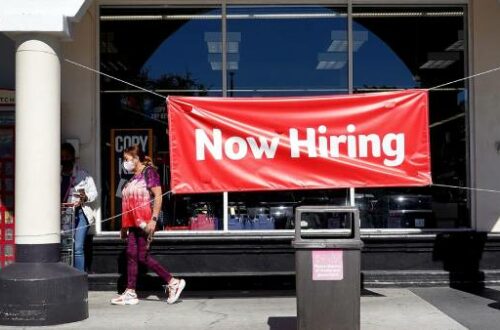
US economic development reconsidered up to 2.3% in second from last quarter, yet at the same time slacked earlier months
- Development took off 6.3% in Q1 and 6.7% in Q2 prior to easing back to 2.3% development in Q3
- Financial experts anticipate that GDP growth should come in around 5.5% this year
- The rise of the delta variation was faulted for the lull in Q3, which runs July 1-Sept. 30
- The development for Q3 came as buyers spent more than whatever was recently suspected and organizations had the option to remake inventories all the more rapidly
Gross domestic product became 2.3% from July to September, as per Commerce Department
U.S. financial development was amended somewhat higher in the second from last quarter, yet at the same time eased back pointedly from the spring in the midst of a flood of COVID-19 contaminations cross country that constrained shoppers to pull back on spending.
The US economy became quicker than anticipated in the second from last quarter of 2021 at 2.3%, up from a gauge of 2.1%.
GDP, the broadest proportion of labor and products created across the economy, developed by 2.3% on an annualized premise in the three-month time frame from July through September, the Commerce Department said in its third and last perusing of the information Wednesday. While that is an expansion from the 2.1% assessed last month, it actually denotes the slowest since the second quarter of 2020, when the economy was in the pains of the most brief, however steepest, downturn in almost a century.
The second from last quarter development in the country’s complete result in labor and products altogether eased back from the initial two quarters where development took off to 6.3% and 6.7% separately.
The second from last quarter lull likewise reflected pandemic-incited interruptions in the store network that restricted the accessibility of merchandise like engine vehicles, just as the vanishing of bureaucratic upgrade cash gave to organizations, families and state and nearby legislatures.
Gross domestic product development is adapted to expansion, which has likewise taken off this year – the Consumer Price Index was up 6.8% in November over last November.
The rise of the delta variation was faulted for the stoppage in Q3, which runs July 1-Sept. 30.
Furthermore with the spread of the Omicron variation and waiting inventory network issues, there are concerns development could slow again heading into 2022.
Typhoon Ida, quite possibly the most impressive storm to at any point make landfall in the U.S., additionally burdened assembling creation, further hampering development.
On Wednesday, President Biden assembled a gathering of his inventory network interruptions team practically and face to face in Washington, where he promoted what he said was huge advancement in mitigating bottlenecks at the ports and different issues that had made deficiencies of products and added to greater costs for shoppers.
In any case, the economy has recaptured steam from that point forward, controlled by strong shopper spending in October as the mid year Covid-19 wave disappeared. The import/export imbalance shrank in October without precedent for months, driven by another record of U.S. sends out as clog at ports and stockrooms cleared. The joblessness rate in November dropped to 4.2%, the least level since the pandemic started.
Biden said that retail inventories are up 3% from keep going year and on-rack accessibility for items is at 91%, near where it was before the pandemic.
Gross domestic product Now, a state-of-the-art tracker observed by the Federal Reserve Bank of Atlanta, is as of now assessing final quarter development of 7.2%.
‘Bundles are moving. Gifts are being conveyed. Racks are not unfilled,’ Biden said.
The quicker than-anticipated development for Q3 came as buyers spent more than whatever was recently suspected and organizations had the option to modify inventories all the more rapidly.
What’s more assuming buyers dread expansion will deteriorate, they will generally spend more money in the transient realizing it will be less important later on, enlarging GDP for the time being and further causing expansion.
Money Street forecasters are toning down their development projections for the following year as expectations blur for President Biden’s general monetary plan and concerns develop about the new Covid-19 variation. Expansion is at the most elevated level in almost forty years, and the Federal Reserve is pushing forward with its arrangements to fix money related approach.
Wednesday’s report showed that shopper spending, which represents 66% of monetary action in the US, was up 2% in the second from last quarter, down from a 12% flood in the April-June quarter.
Business analysts anticipate that GDP growth should come in around 5.5% this year, which would be the quickest development starting around 1984 and would switch last year when the economy shrank by 3.4% as 22 million positions were cleared out.
The Federal Open Market Committee said at the finish of its two-day strategy setting meeting last week that it would twofold the decrease of its resource buy program to $30 billion every month, a timetable that could deliberately transition away from the buys completely by March rather than the first June direction spread out a month ago.
Oxford Economics has managed its conjecture for financial development for the current quarter from 7.8% to 7.3%, which would in any case address a sizable bounce back from the second from last quarter lull.
Despite the fact that policymakers casted a ballot to hold rates almost zero, where they have sat since March 2020, new monetary projections show that each Fed official has planned for no less than one rate climb one year from now – an impressive shift from September, when a big part of the national investors accepted loan fee increments were not justified until somewhere around 2023.
Lucas Jacob is an english poet, playwriter and actor. He has written many poems and short stories. He completed MBA in finance. He has worked for a reputed bank as a manager. Greg has found his passion to write and express, that is why he has decided to become an author.
Disclaimer: The views, suggestions, and opinions expressed here are the sole responsibility of the experts. No STOCK INVESTS journalist was involved in the writing and production of this article.





